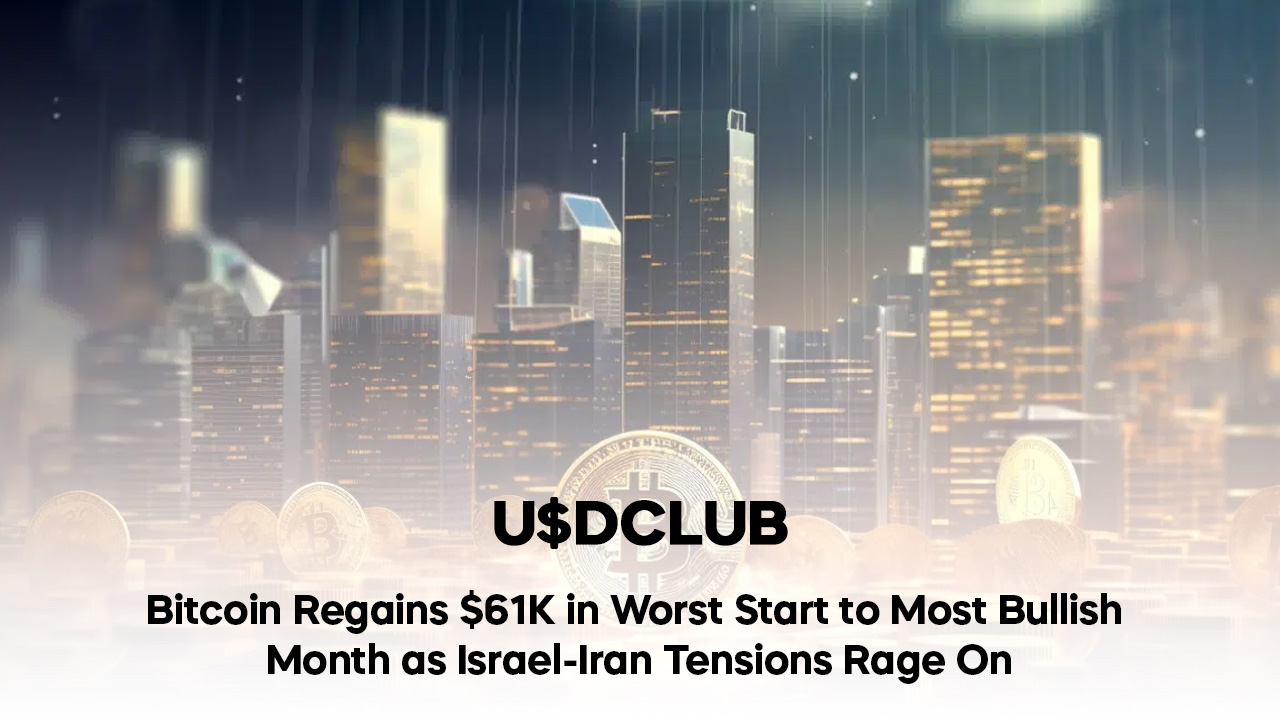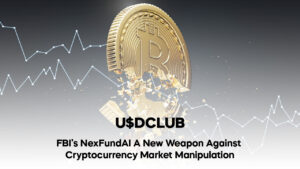As Bitcoin reclaims the $61,000 mark, the cryptocurrency market finds itself in a unique position—caught between global geopolitical instability and historical trends pointing toward bullish growth. The resurgence of Bitcoin’s price amid growing Israel-Iran tensions serves as a stark reminder that cryptocurrency is no longer immune to traditional geopolitical events. This blog will dive deep into the recent rise of Bitcoin, how geopolitical tensions have influenced its price, and what investors should expect moving forward as we enter what is historically considered the most bullish month for the digital currency.
The Rebound: Bitcoin’s Journey Back to $61K
October has long been considered a bullish month for Bitcoin. Historically, the final quarter of the year has seen Bitcoin prices soar as increased institutional interest, retail participation, and favorable macroeconomic trends coalesce. However, October 2024 started on a different note, marked by volatility, global conflicts, and a growing sense of market unease.
In early October, Bitcoin dipped below critical support levels, leading many investors to worry that a more significant bear market might be underway. Concerns over inflation, rising interest rates, and increased regulatory scrutiny in key markets like the United States and the European Union exacerbated these fears. However, just as quickly as Bitcoin lost ground, it regained momentum, climbing back above $61,000—a key psychological threshold.
Several factors contributed to this recovery:
- *Institutional Buy-In*: As the price dipped, institutional investors saw an opportunity to accumulate Bitcoin at lower prices. Investment funds, corporate treasuries, and family offices capitalized on the temporary weakness, helping to fuel the rebound.
- *Positive Sentiment*: Despite early volatility, long-term market sentiment remains bullish. Many analysts believe that Bitcoin is on the cusp of another major bull run, driven by supply constraints, growing adoption, and the ongoing narrative of Bitcoin as “digital gold.”
- *On-Chain Data*: Blockchain analytics showed an increase in wallet activity, signaling that long-term holders were not selling despite short-term volatility. The rise in wallet activity, combined with reduced exchange reserves, suggests that more investors are holding Bitcoin off exchanges—a classic indicator of a bullish market.
Geopolitical Tensions: Israel-Iran Conflict and Bitcoin’s Role
While market fundamentals and historical trends point toward bullish momentum, geopolitical tensions have added a layer of complexity to Bitcoin’s recent price action. In particular, the ongoing Israel-Iran conflict has captured global attention, sending ripples across financial markets, including cryptocurrencies.
How Geopolitical Events Impact Bitcoin Prices
Bitcoin has long been seen as a “safe-haven” asset, similar to gold, during times of economic or political uncertainty. In times of war, inflation, or economic downturns, investors often flock to assets that are outside of traditional financial systems. Bitcoin, with its decentralized nature and deflationary model, fits this bill perfectly.
The Israel-Iran conflict has escalated in recent months, leading to growing concerns over potential impacts on global energy markets and broader economic stability in the Middle East. As tensions rise, many investors are turning to Bitcoin as a hedge against potential market turmoil. Key reasons for this include:
- *Currency Stability*: During periods of geopolitical instability, national currencies can experience volatility or devaluation. Investors in regions directly affected by the conflict may look to Bitcoin as a way to preserve wealth, particularly if they anticipate inflationary pressures on their local currency.
- *Decentralization and Autonomy*: Unlike traditional assets, Bitcoin is not subject to government controls or sanctions. For individuals and institutions in conflict zones, Bitcoin offers an opportunity to store and transfer wealth without relying on traditional banking systems that may be disrupted by war or political unrest.
- *Inflation Hedge*: Geopolitical tensions often lead to inflationary pressures, particularly in commodity markets such as oil. As energy prices rise, global inflation tends to follow. Bitcoin’s fixed supply and deflationary nature make it an attractive alternative for investors looking to hedge against rising inflation.
Historical Bullishness in October
Bitcoin’s historical performance in October has been a significant factor in market optimism for 2024. The fourth quarter of the year has traditionally been a time when Bitcoin rallies, driven by multiple factors:
- *Institutional FOMO*: Fear of missing out (FOMO) among institutional investors often leads to increased buying pressure toward the end of the year. Fund managers looking to close out the fiscal year on a strong note may increase their allocations to Bitcoin as a hedge against inflation or declining equity markets.
- *Retail Investor Interest*: As Bitcoin approaches its all-time highs, retail investors typically flood into the market, driven by media coverage and social media hype. Historically, October has seen a surge in retail buying activity, contributing to the bullish momentum.
- *Favorable Macroeconomic Conditions*: Historically, macroeconomic trends have also favored Bitcoin during the final quarter of the year. Central banks typically enter a more dovish stance as they prepare for year-end monetary policy decisions. Lower interest rates, quantitative easing, and other expansionary policies have historically supported Bitcoin’s price growth.
- *Holiday Spending*: The final quarter of the year is marked by increased consumer spending, both in traditional markets and in the cryptocurrency space. As more individuals gain disposable income and participate in holiday spending, some of that money flows into Bitcoin and other digital assets, driving up demand.
The Role of Institutional Investors
Institutional participation in the Bitcoin market has grown significantly in recent years, and this trend is playing a critical role in the current price resurgence. Institutions, including pension funds, hedge funds, and family offices, are increasingly viewing Bitcoin as a long-term investment opportunity.
*Key Institutional Drivers*:
- *Hedge Against Inflation*: With inflation rates climbing globally, institutions are increasingly looking to Bitcoin as a hedge. Bitcoin’s deflationary nature—capped at 21 million coins—offers an alternative to traditional inflation-hedging assets like gold.
- *Portfolio Diversification*: Institutions are also incorporating Bitcoin as part of broader portfolio diversification strategies. Bitcoin’s lack of correlation with traditional assets such as stocks and bonds makes it an attractive option for reducing overall portfolio risk.
- *Grayscale and Other Investment Products*: Financial products such as Grayscale’s Bitcoin Trust and Bitcoin ETFs are making it easier for institutions to gain exposure to Bitcoin without the complexities of directly purchasing and storing the asset. As more of these products become available, institutional inflows into Bitcoin are expected to increase.
Regulatory Landscape
While institutional and retail investors remain bullish on Bitcoin, regulatory uncertainty continues to pose a risk to the market. In the U.S., the Securities and Exchange Commission (SEC) has been slow to approve a spot Bitcoin ETF, citing concerns over market manipulation and investor protection. However, growing pressure from the financial community and the success of Bitcoin ETFs in other countries, such as Canada, have led many analysts to believe that approval is inevitable.
Regulatory developments are also unfolding in other parts of the world:
– *Europe*: The European Union is moving closer to introducing comprehensive cryptocurrency regulations. The Markets in Crypto-Assets (MiCA) regulation aims to provide a clear legal framework for cryptocurrencies and related services, which could foster greater institutional participation.
– *Asia*: In Asia, regulatory stances vary widely. China continues to maintain its ban on cryptocurrency trading and mining, while other countries like Singapore and South Korea have embraced digital assets and are working on clear regulatory frameworks to support their growth.
Bitcoin’s Supply Dynamics
One of the most critical factors influencing Bitcoin’s price is its supply dynamics. Unlike traditional assets, Bitcoin’s supply is capped at 21 million coins, with roughly 19 million already in circulation. This limited supply makes Bitcoin inherently deflationary, meaning that as demand increases, the price is likely to rise.
In addition to Bitcoin’s fixed supply, the upcoming “halving” event—scheduled for 2024—is expected to further reduce the rate of new Bitcoin entering circulation. This halving event, which occurs every four years, reduces the reward for mining Bitcoin by 50%. Historically, Bitcoin’s price has surged in the months leading up to and following a halving event.
The Path Forward
As we enter the final months of 2024, the path forward for Bitcoin is rife with potential. While geopolitical tensions, inflation, and regulatory uncertainty pose challenges, the overall outlook remains bullish. Key factors that will drive Bitcoin’s price include:
- *Institutional Adoption*: Continued institutional inflows will be critical to sustaining Bitcoin’s price momentum. As more financial products become available and regulatory clarity improves, institutions are likely to increase their allocations to Bitcoin.
- *Geopolitical Stability*: Geopolitical events will continue to impact Bitcoin’s price. While conflict in the Middle East and tensions between Israel and Iran may drive demand for Bitcoin as a safe-haven asset, any resolution of these conflicts could lead to market fluctuations.
- *Regulatory Clarity*: Regulatory developments, particularly in the U.S. and Europe, will play a key role in shaping the future of Bitcoin. The approval of a spot Bitcoin ETF in the U.S. could act as a major catalyst for the market.
- *Supply Constraints*: As Bitcoin’s supply continues to decrease and demand rises, the scarcity of the asset will likely drive prices higher. The upcoming halving event will further accentuate these supply constraints.
Conclusion
Bitcoin’s recent climb back to $61,000 amid one of the most geopolitically volatile months underscores the asset’s growing importance as a global store of value. As we enter the most bullish month for Bitcoin, investors should prepare for heightened volatility but remain optimistic about the long-term potential of the cryptocurrency market.
For more updates on the latest developments in the cryptocurrency market and insightful investment strategies, stay tuned to *USDCLUB.us*, where we provide timely news and analysis from the world







